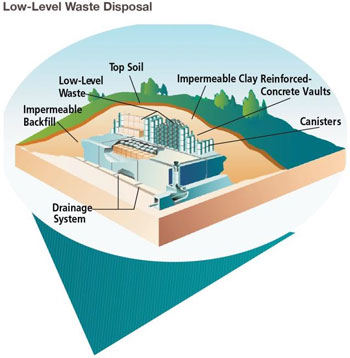Backgrounder on Updating Disposal Rules for Low-Level Waste
On this page:
The Nuclear Regulatory Commission is amending its rules for the disposal of low-level radioactive waste to include depleted uranium left over from the uranium enrichment process. This waste did not exist in large quantities and was not analyzed when the current rules were put in place. Before it can be disposed, the new rules will require an analysis of the specific disposal facility and the specific quantity of waste. This analysis would show whether the overall system can safely contain the waste.
Background
 Low-level waste is defined as radioactive waste that is not spent nuclear fuel, transuranic waste, uranium mill tailings (sandy residue from processing uranium ore) or high-level waste. It also includes certain types of material known as byproduct material. It has been contaminated with radioactive materials or is radioactive itself. Low-level waste includes protective clothing, cleaning supplies, filters, sealed sources, components from nuclear power plants, medical equipment and laboratory tissues.
Low-level waste is defined as radioactive waste that is not spent nuclear fuel, transuranic waste, uranium mill tailings (sandy residue from processing uranium ore) or high-level waste. It also includes certain types of material known as byproduct material. It has been contaminated with radioactive materials or is radioactive itself. Low-level waste includes protective clothing, cleaning supplies, filters, sealed sources, components from nuclear power plants, medical equipment and laboratory tissues.
Depleted uranium also meets the NRC's definition of low-level waste. Depleted uranium is unique because it actually becomes more radioactive as it decays over thousands of years. While reviewing license applications for new commercial uranium enrichment facilities, NRC staff began planning for the need to dispose of this material.
The NRC is responsible for ensuring the safe disposal of low-level waste from commercial activities. NRC regulations found in 10 CFR Part 61 set minimum standards for the performance of disposal facilities to protect public health and the environment. The regulations give operators flexibility in how to meet those standards. When the rules were developed, no commercial facilities were producing large amounts of depleted uranium. So, the impacts of disposing of this waste were not explicitly considered.
The staff prepared a technical analysis that concluded safe disposal of this waste depends on the specific geology, geography and climate of the disposal site. The Commission then directed the staff to amend NRC regulations and provide guidance for meeting them. The new rules will require a site-specific analysis for disposing of depleted uranium in large quantities.
Low-Level Waste Disposal Sites
Low-level waste is sent to licensed, privately operated disposal facilities. Either the NRC or an Agreement State issues the license, which specifies the classes of waste the facility can accept. The four active low-level waste disposal facilities in the United States are in Agreement States:
- EnergySolutions Barnwell Operations, Barnwell, S. C.
- U.S. Ecology, Richland, Wash.
- EnergySolutions Clive Operations, Clive, Utah
- Waste Control Specialists, Andrews, Texas
Rulemaking Process
There are several steps to the NRC process for developing the new rule. In September 2009, the NRC held public workshops to solicit early input on issues associated with the rulemaking. Using that input, the NRC developed a technical document to support the new rule. The agency also took comments on several preliminary versions of proposed rule language. Based on that feedback, the agency published the proposed rule for comment. With Commission approval, the NRC will publish a final rule in the Federal Register. It would become effective one year after the final rule is published. Agreement States will have three years from the publication date to adopt compatible regulations.
For more details, see these documents related to the rulemaking.
June 2019
Page Last Reviewed/Updated Tuesday, July 23, 2019
Page Last Reviewed/Updated Tuesday, July 23, 2019

